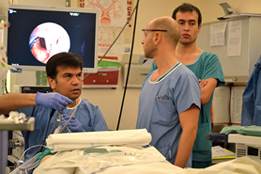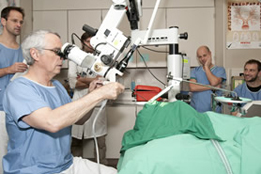What is the first step in treatment?


Endoscopic evaluation & diagnosis
Before we can treat the airway, it is extremely important to have the correct diagnosis that helps in treatment planning for the surgery of each individual patient.
At the CHUV, we have the State-of-Art endoscopy suite (Centre d'endoscopie du CHUV) managed by highly skilled endoscopy surgeons, anesthetists and the support staff. It has the latest technology in endoscopy to allow for a precise diagnosis and surgical intervention.
Endoscopic procedures are used to establish a diagnosis for the actual treatment of the airway stenosis and in performing complementary interventions after open surgeries. Endoscopic pictures and videos allow us to study the minute details of the pathology and find the right solution for it.
They also serve as a database during the actual surgery and help in comparing results before and after the operation, as well as in the follow up surveillance period. The pictures are shared with the patient and his family who can then understand and follow the treatment strategy.
You have had already an endoscopy. Do you have to repeat it in Lausanne?
When patients are referred to us, they often have already had an endoscopy and other studies done in their home country. It is important for us to review these studies carefully, but we must also begin with an endoscopic review in our endoscopy suite here in Lausanne. As it is the most important study that helps us in making the diagnosis and planning the treatment.
We follow a systematic approach while doing the endoscopy. While the patient is under light anesthesia, we perform an awake and sleep endoscopy that mimics the dynamic functions of the airway. The latest in aero-digestive endoscopy technology and ideal anesthesia conditions, administered by our airway specialist anesthesiologists, allow us to do this very precise endoscopy. The patient is then put under general anesthesia and the entire upper and lower airway is more carefully inspected. This endoscopy provides us with the most critical information to establish a baseline and to then make a proper surgical plan.



